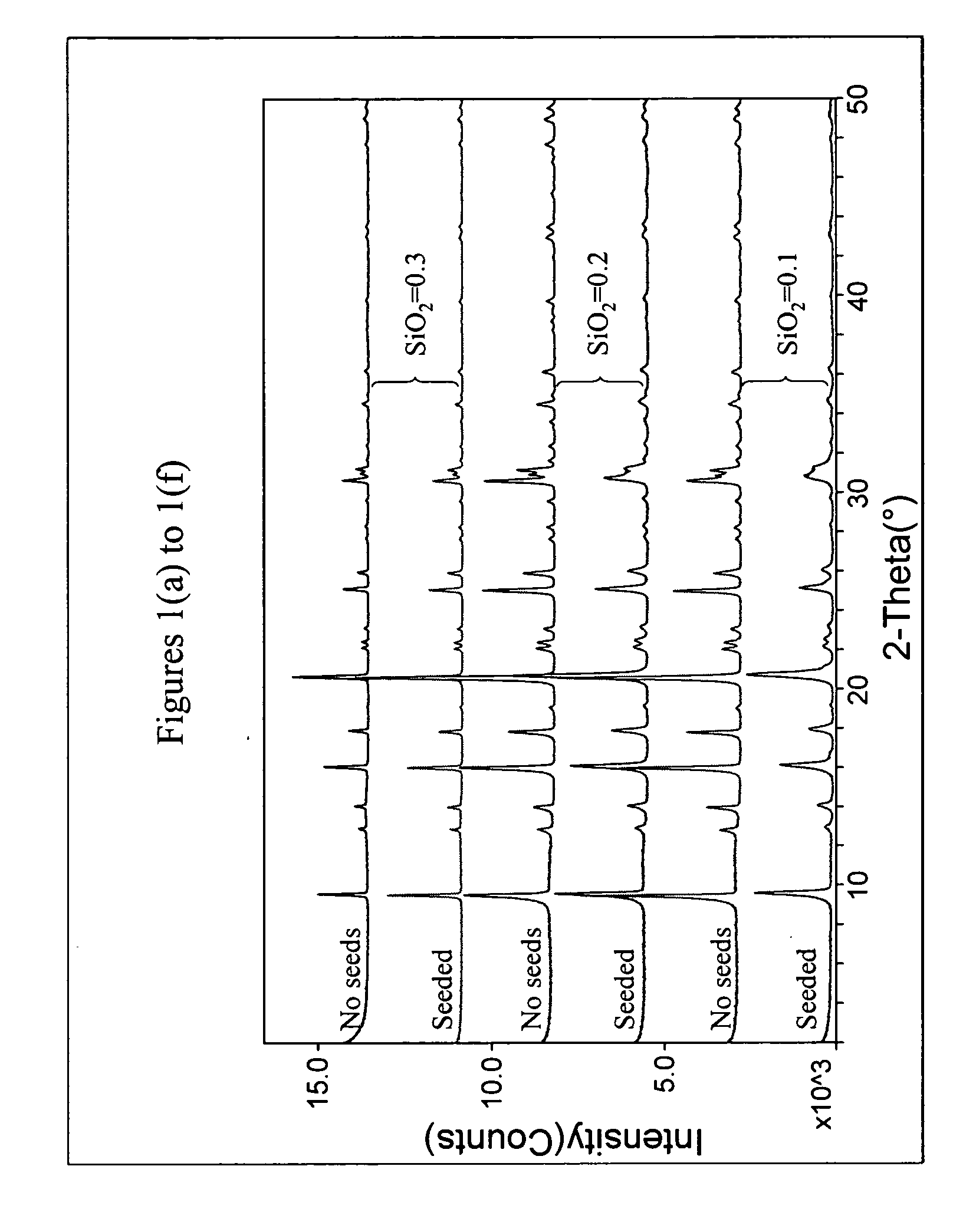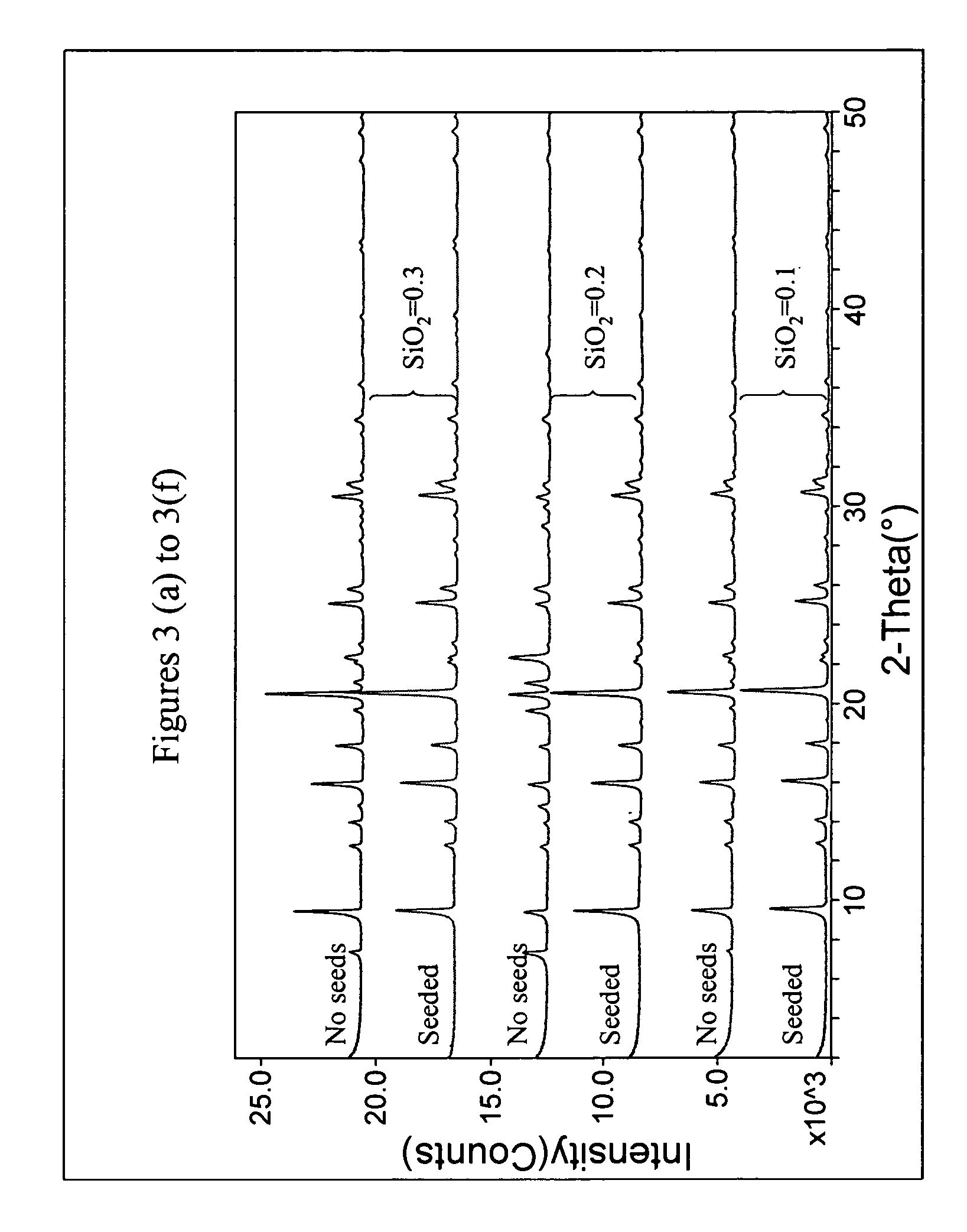Synthesis of molecular sieves having the chabazite framework type and their use in the conversion of oxygenates to olefins
a technology of chabazite and molecular sieves, which is applied in the direction of physical/chemical process catalysts, hydrocarbon oil treatment products, silicon compounds, etc., can solve the problems of limiting catalyst life, increasing the potential for undesired secondary reactions, and lowering the diffusion rate of reactants and products
- Summary
- Abstract
- Description
- Claims
- Application Information
AI Technical Summary
Benefits of technology
Problems solved by technology
Method used
Image
Examples
example 1
Preparation of Trimethylcyclohexylammonium (TMCHAOH) Template
[0068] To a solution of 50.0 g N,N-dimethylcyclohexylamine (DMCHA, 0.393 mole) in 50 g ethanol, contained in a round-bottom flask and chilled with an ice bath, was added drop-wise 66.9 g iodomethane (0.472 mole) over 30 minutes with stirring. All reagents were reagent grade from Aldrich and were used as received. The reaction proceeded gradually, forming a white precipitate. The mixture was allowed to warm up to room temperature and the reaction was continued for another five hours with stirring and occasional shaking. The mixture was then chilled in a refrigerator (3° C.) before the solid product was isolated by filtration. The solid was washed with chilled acetone before drying in air at room temperature. The isolated trimethylcyclohexyl-ammonium iodide (TMCHAI) weighed 107.5 g (yield 92.0% based on DMCHA).
[0069] Ion exchange of the TMCHAI to the hydroxide form was performed by first dissolving 60.0 g TMCHAI (0.223 mol...
example 2
Preparation of [SAPO]-CHA Using Trimethylcyclohexylammonium (TMCHAOH) As Template
[0070] The following ingredients were mixed, in sequence, and blended into a uniform gel using a microhomogenizer (Tissue Tearor Model 98730 available from Biospec Products, Inc, USA): 85 wt % H3PO4 (obtained from Aldrich Chemical Company), H2O, Catapal™ A (74 wt % Al2O3, available from CONDEA Vista Company, Texas, USA), Cabosil™ silica (available from Cabot Corporation, Illinois, USA), and then 30% trimethylcyclohexylammonium hydroxide (TMCHAOH), obtained as described in Example 1. Three separate mixtures were produced with molar ratio of the ingredients being as follows:
1.5 TMCHAOH:1.0 Al2O3:(0.1, 0.2, and 0.3) SiO2:1.0 P2O5:40 H2O
[0071] As a more detailed example, for SiO2=0.1 mixture, 0.93 g deionized H2O was first added to 5.72 g 85 wt % H3PO4. Then 3.42 g Catapal™ A, 0.17 g Cabosil™ and 19.75 g 30% trimethylcyclohexylamine were sequentially and slowly added with thorough mixing (using the homog...
example 3
Preperation of [SAPO]-CHA Using Phenyltrimethylammonium (PTMAOH) As Template
[0074] The procedure of Example 2 was followed, except that the template was 25 wt % aqueous solution of phenyltrimethylammonium hydroxide, which was obtained from Fluka Chemika, Switzerland. Three separate gel compositions were prepared having the following oxide molar ratios.
1.5 PTMAOH:1.0 Al2O3:(0.1, 0.2, and 0.3) SiO2:1.0 P2O5:45 H2O
[0075] Each gel was divided into 2 portions, to one of which were added 100 ppm colloidal SAPO-34 seeds while no seeds were added to the other portion. Crystallization was carried out at 170° C. for three days in a tumbling oven at 40 rpm. FIGS. 3 (a) to (f) show the XRD pattern of the products obtained. The results clearly show that essentially pure [SAPO]-CHA was obtained when seeds were used. Without seeding, however, the products were all contaminated with crystalline impurity having the AFI framework.
[0076] Table 3 shows the product yields and the results of elementa...
PUM
| Property | Measurement | Unit |
|---|---|---|
| Percent by mass | aaaaa | aaaaa |
| Percent by mass | aaaaa | aaaaa |
| Percent by mass | aaaaa | aaaaa |
Abstract
Description
Claims
Application Information
 Login to View More
Login to View More - R&D
- Intellectual Property
- Life Sciences
- Materials
- Tech Scout
- Unparalleled Data Quality
- Higher Quality Content
- 60% Fewer Hallucinations
Browse by: Latest US Patents, China's latest patents, Technical Efficacy Thesaurus, Application Domain, Technology Topic, Popular Technical Reports.
© 2025 PatSnap. All rights reserved.Legal|Privacy policy|Modern Slavery Act Transparency Statement|Sitemap|About US| Contact US: help@patsnap.com



